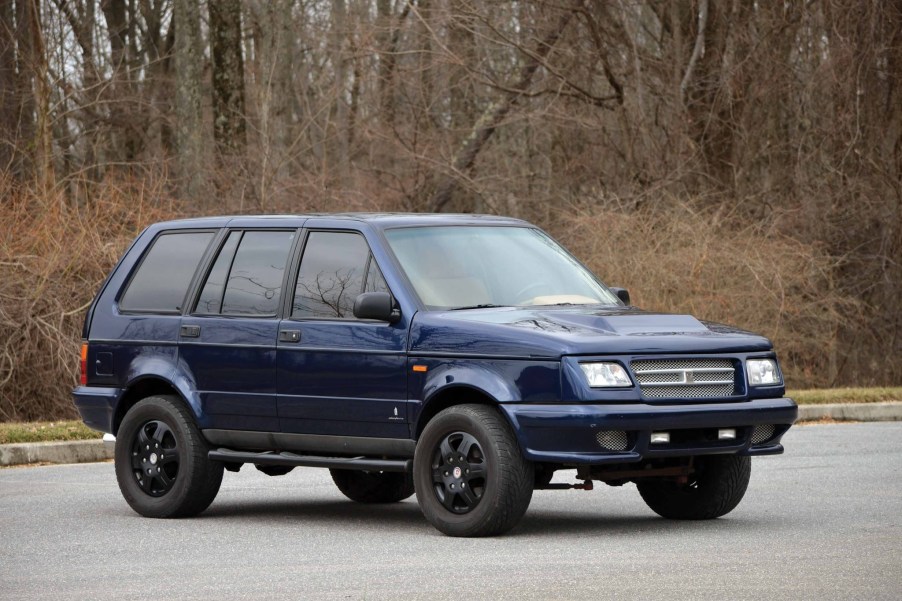
The Laforza Is Italy’s Forgotten Classic Range Rover SUV Rival
Even compared to other luxury SUVs, the Range Rover lineup is in a league of its own. And the British luxury SUV’s pop-culture presence isn’t limited to its brand-new versions. Classic Range Rovers aren’t just rising in value—they’re also becoming popular restomod bases. However, as vintage SUVs like Range Rovers and Land Cruisers enjoy the limelight, some other interesting oddballs wallow in obscurity. And that includes an oft-ignored Italian SUV that tried battling the Range Rover with performance: the Laforza.
To make a classic Italian Range Rover competitor, just add an American V8 to a Magnum

If you haven’t heard of the Laforza, that’s not surprising. For one thing, that wasn’t the Italian luxury SUV’s only name. It started life in the mid-1980s as the Rayton-Fissore Magnum—only the American-market models bear the ‘Laforza’ name, Hagerty explains. And explaining why requires diving into this obscure SUV’s backstory.
The Laforza is the brainchild of Italian design house Fissore, hence the ‘Fissore’ part in the Magnum’s full name. But Fissore didn’t design this SUV itself. Instead, Tom Tjaada, the Dutch-American designer behind cars like the DeTomaso Pantera and original Fiat 124 Spider, penned its looks. However, Tjaada only designed the original 1984 Magnum. Shortly after it came to the US as the 1989 Laforza, the SUV got a styling update courtesy of Pininfarina.
A new look wasn’t the only thing the Laforza got when it came to the US, though. In Europe, the Magnum was available with a variety of engines from home-market OEMs, Road & Track reports. Buyers could choose from a Lancia four-cylinder, Alfa Romeo’s Busso V6, as well as a BMW turbodiesel and 3.4-liter inline-six. However, recognizing that American buyers cared more about power than fuel economy, Rayton-Fissore knew its SUV needed something bigger.
So, when the Laforza launched in 1989, it didn’t have a six-cylinder or turbodiesel four-cylinder. Besides reinforcing the frame, Rayton-Fissore also installed a Ford V8 4WD powertrain. And the oddities—and performance gains—didn’t stop there.
The Laforza was quick and quirky but it couldn’t match the Range Rover’s brand appeal

| Spec | 1989-1999 Laforza |
| Engine | 1989-1997: 5.0-liter Ford F-150 V8, 5.0-liter Ford Mustang V8 with optional supercharger 1998-1999: 5.0-liter Ford Explorer V8 with optional supercharger, 6.0-liter GM supercharged Vortec V8 |
| Power | 1989-1997: 185 hp (F-150), 225/300 hp (Mustang base/supercharged) 1998-1999: 225/320 hp (Ford, base/supercharged), 350+ hp (GM, Road & Track) |
| Torque | 1989-1997: 270 lb-ft (F-150), 285/325 lb-ft (Mustang, base/supercharged) 1998-1999: 280/350 lb-ft (Ford, base/supercharged) |
| Transmission | Four-speed automatic |
| Drive type | 1989-1997: Four-wheel drive with two-speed transfer case 1998-1999: Full-time four-wheel drive |
| Curb weight | 5260 lbs (1998 supercharged model, Car and Driver) |
| 0-60 mph time | 9.9 seconds (Car and Driver) |
In a world with things like the Lamborghini Urus and Dodge Durango Hellcat, performance SUVs aren’t exactly unusual. But they didn’t really exist in 1989 when the Laforza launched. The closest thing was the Lamborghini LM002, and that was technically a pickup truck.
Admittedly, by the late 1990s, automakers started pursuing high-speed SUVs and trucks. Land Rover got the Range Rover in on the trend, too, with models like the 4.6HSE. But even so, a luxury SUV that could go 0-60 mph in under 10 seconds in 1998 was a rarity, Hagerty notes.
However, the Laforza can’t stop nearly as well as it goes. Not only does it lack ABS, but it has rear drum brakes. Plus, it’s wider and taller than the contemporary Chevrolet Suburban, Car and Driver says. And the 1998 model is about 500 pounds heavier than the SUV it got its engine from, the Ford Explorer.
But while the Laforza is a luxury SUV, its premium features are balanced out by some less-glamorous quirks. Yes, it has a sturdy Italian military truck frame, an optional built-in radar detector, leather upholstery, wood trim, and plenty of interior space. However, while the 1998 model has a limited-slip differential, it also has torsion-bar front suspension and rear leaf springs. And not only does it lack ABS, but the Laforza also doesn’t have airbags or even cruise control.
Plus, the lack of features came with a high price. In 2000, a supercharged Laforza cost $67K, the equivalent of $106.7K. And while a classic Range Rover is rather recognizable, the same can’t be said for the Italian SUV.
Obscurity has its benefits—this is one cheap classic luxury performance SUV
With all of these downsides, it’s perhaps unsurprising that the Laforza wasn’t particularly successful. Rayton-Fissore made roughly 6000 Magnums, though only about 1200 are Laforzas. That makes this a rather rare classic luxury SUV.
However, the upside is that it’s also a rather cheap one. That includes the rare GM-powered Magnum Edition; one sold at a 2018 RM Sotheby’s auction for $4125. A good-condition example typically costs about $10K, while even pristine examples top out at roughly $25K, Hagerty says.
And while it may have Pininfarina styling, the Laforza uses plenty of Fiat switchgear, not to mention a Ford powertrain. So, there’s no shortage of replacement parts. Plus, in terms of interior quality, the Italian SUV arguably beats a classic Range Rover, Hagerty reports. Also, remember that it comes standard with 4WD and can genuinely go off-road, Car and Driver says.
True, a Laforza doesn’t have quite the same level of badge recognition as a Range Rover. But then, isn’t rarity also a sign of luxury?
Follow more updates from MotorBiscuit on our Facebook page.


